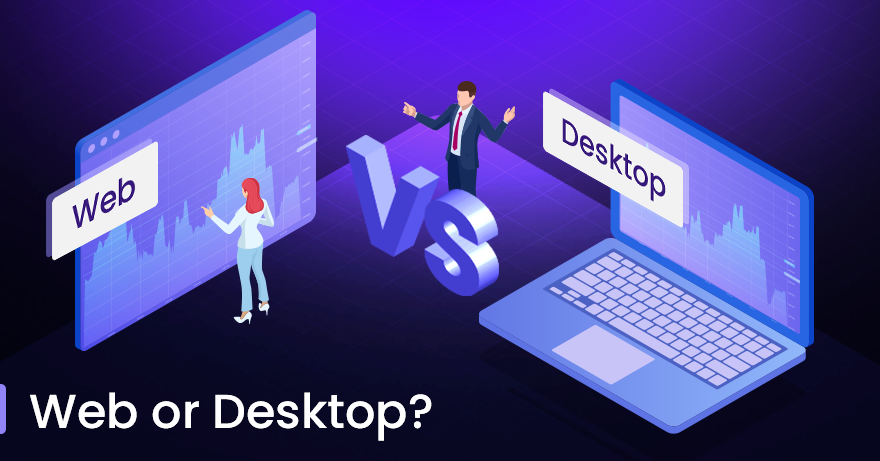
How “Sticky” is Your Brokerage’s User Experience?
October 20, 2021
Panda. Brokerage Marketing 101
November 15, 2021
You’ve probably come across lots of different articles discussing the pros and cons of desktop vs web-based applications over the years. Some compare the technologies in general, without talking specifically about trading. Others are specifically aimed at traders, but many of these take their lead from the general consensus about web-based vs desktop in the broader technology space.
Without wishing to rehash the entire debate, here is a very simple “Cliffs Notes” version of how it’s generally thought that web-based stacks up against desktop.
General Comparison
|
Desktop Applications
|
Vs
|
Web-based Applications
|
|
Manual installation and update required |
Installation & Update |
Not required |
|
Able to run complex, resource-heavy calculations |
Performance
|
Resource-heavy applications may cause problems
|
| Full feature sets
|
Features
|
Scaled-down feature sets
|
It’s not that simple
The problem with comparisons of this type is that they are not domain-specific. In other words, what types of processes is your application running? What does it mean to have a full feature set in your domain?
When you consider the unique needs of financial trading platforms, the comparison of desktop vs web-based looks quite different. For one, trading platforms are not very resource hungry, comparatively speaking. In other words, there’s not much a desktop platform does, other than complex backtesting, that today’s web-based technologies and high bandwidth connections can’t match.
The same is true when you look at feature sets. Today’s web-based platforms come with all the features of their desktop counterparts, with the addition of being even easier to use. This is because a lot of attention goes into UX design in web-based platforms because they’re created to work on anything with a browser.
Additionally, the cross-platform nature of web apps means that it’s more efficient and ultimately cheaper to develop a single solution for all rather than needing a different team for each operating system and type of device.
What about security?
We didn’t think it deserved a place in the table above, but you often find security coming up in discussions of desktop vs web, with desktop often given the nod as being more secure. Perhaps this may have been true in the earliest days of the Internet, but today many of the most important applications we interact with on a daily basis (banking, government agencies, online purchases, trading), are almost entirely web technologies with web-based interfaces.
Furthermore, with trading being such a high-value online activity, brokers place an enormous amount of emphasis on security. At Panda, we know this all too well, encryption of all data on the broker’s side is becoming standard practice, with measures in place to prevent data theft from taking place both via external attack or internal leak.
Stickiness
Web-based interfaces tend to be stickier than their desktop equivalents. They don’t have to be sourced, downloaded, unpacked, installed and then regularly updated. For these reasons, clients who get to grips with how your web app works are highly likely to continue returning.
This is especially so if you use web app development as an opportunity to integrate extra key services other than trading.
At Panda, for instance, we have seen an explosion in brokers wishing to integrate their account registration/login screens and client areas into the trading platform so that their clients are always interacting with the same interface. These brokers have realised the stickiness of web-based interfaces when executed correctly.
New Skin, Old Foundations
Last but not least, a web app can function as a fresh skin over the existing server infrastructure, allowing for systems like MT4 and MT5 to be used in conjunction with a whole new look for your brokerage. The above platforms still enjoy a huge market share, but it’s hard to stand out from the crowd when you’re offering the same platform as your competitors.
At Panda, we’ve taken on several high profile development contracts that have involved incorporating all of the features mentioned above (all in one web-based interface for registration, account management and trading) while keeping the trading back end the same. Our clients have found it to be a cost-effective way to keep what works in their architecture and add what was previously lacking.
For small-to-medium brokers, this can be the differentiating factor. It allows them to inject a degree of uniqueness into their offering, without having to undergo the expenses of a fully custom development.
Contact Us
If you’re considering upgrading your existing trading interface, or are setting up a new brokerage from scratch, feel free to get in touch for a consultation. Our team of success managers will be able to appraise your individual case and offer a tailored solution.
For free consultation
Request a Call
